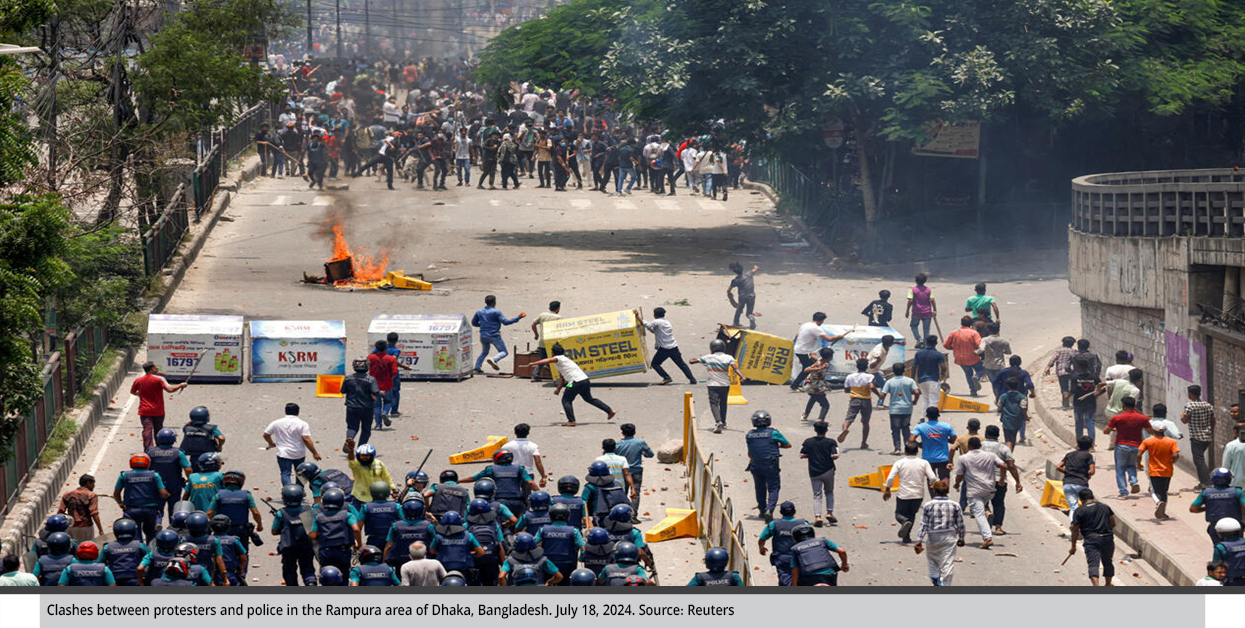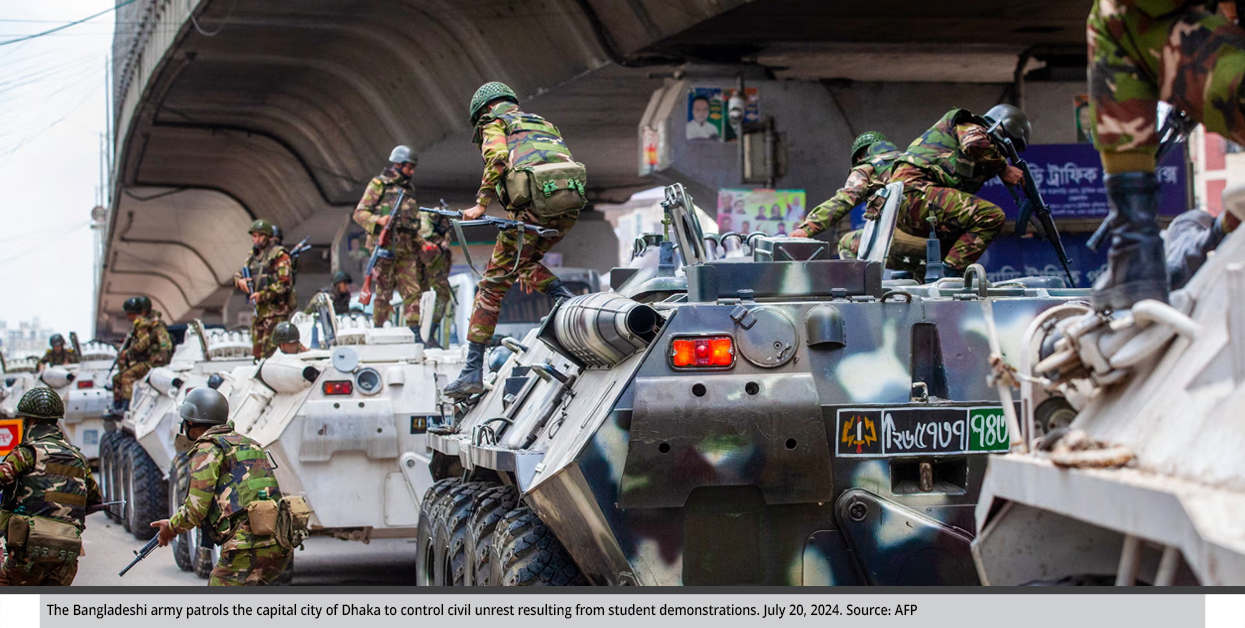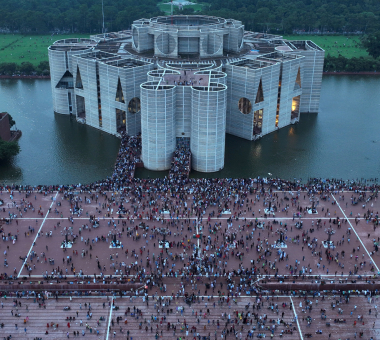After more than a month of ongoing student and popular protests in Bangladesh that resulted in thousands of casualties and injuries among protesters and police, Prime Minister Sheikh Hasina Wajed announced her resignation on August 6, 2024. Her immediate departure to India was quickly followed by Bangladeshi President Mohammad Shahabuddin releasing the former prime minister and leader of the opposition Bangladesh Nationalist Party (BNP), Khaleda Zia, along with other detainees, and lifting the curfew. Two days later, on August 8, under pressure from the student movement that led the protests, Dr. Muhammad Yunus, a 2006 Nobel Peace Prize laureate and the recipient of the U.S. Presidential Medal of Freedom in 2009 and the Congressional Gold Medal in 2010, was sworn in as the head of a temporary government.
Although these protests began in early July 2024, led by the Students Against Discrimination (SAD) movement and followed several months after the parliamentary elections in January 2024, they were reignited by student movements protesting the quota system in government employment. However, these protests are not isolated from the broader historical, political, economic, and social context of the country, and they raise many questions about their roots, drivers, and future implications both within the country and in neighboring states.
The Movement’s Factors and Escalations
The SAD movement led the recent wave of protests in Bangladesh. However, the success of this movement came in the context of interactions between various internal and external factors that helped fully develop the conditions necessary for its success.
First: The continuous state of opposition movement since Hasina was elected for the fourth consecutive time since 2009, after her party, the Awami League, won the parliamentary elections held his January amidst a boycott by most opposition parties, especially the BNP and Islamic parties. Voter turnout was low: 40%.
It is likely that the opposition relied on U.S. support to form a neutral government, as Washington had previously taken steps to support the transfer of power in Bangladesh, notably by implementing a new visa system that allows U.S. authorities to deny visas to individuals and entities accused of obstructing free and fair elections in the country. Similarly, the European Union did not send observers to the elections, claiming that they lacked integrity and freedom.

Second: The structural connection between the political systems of Bangladesh and India is a political, security, and economic link that began with the establishment of Bangladesh and the rule of Sheikh Mujibur Rahman, the leader of the Awami League. This connection has been strengthened during the tenure of his daughter Hasina. India supported the recent parliamentary elections won by Hasina due to its vested interests, particularly economic ones, as the volume of bilateral trade between the two countries exceeded $15 billion in 2022. Additionally, India is concerned about Hasina’s rivals, whether they are Islamists or the BNP, which is closer to Pakistan.
Third: The public discontent with the quota system for government jobs that was instituted with the establishment of Bangladesh in 1971. This system allocates more than 50% of the important and prestigious positions in the state to specific groups, such as the children of veterans, individuals close to the ruling party, and their relatives. Student protests in 2018 led Hasina to abolish this law, but the Supreme Court reinstated it in June 2024.
Fourth: The economic conditions have intensified protests against the Supreme Court’s decision. According to Reuters, youth unemployment rates are high, with nearly 23 million unemployed out of a total population of 170 million. The public sector remains the primary driver of job creation, while demand for jobs in the private sector is low.
Fifth: The protests began as strikes by faculty members and students at public universities in response to the government’s proposal of a bill to reform the pension system, which included salary deductions. The strike led to the closure of all public universities, including the University of Dhaka, which had played a central role in the rise of Bengali nationalism and the independence of Bangladesh in 1971. However, the government’s failure to meet their demands prompted the protesters to take to the streets, leading to clashes with the police that resulted in the deaths of thousands of protesters. A curfew was imposed and the army was deployed to help restore order, but these measures failed to control the situation, which escalated and deteriorated severely.
Sixth: The ongoing conflict between Pakistan and Bangladesh, which was part of the discourse accompanying the protests. In fact, Hasina described the protesters from the early days as rajakar, a derogatory term used during the 1971 independence war to refer to citizens loyal to Pakistan, many of whom were accused of horrendous crimes. Additionally, the role of the banned Islamist political party Jamaat-e-Islami in Bangladesh, which has strong ties with the Jamaat-e-Islami group operating in Pakistan, was highlighted. The leader of Jamaat-e-Islami in Bangladesh, Sheikh Shafiq Rehman, expressed his full support for the new government and called on the Indian government to hand over Hasina for trial in Bangladesh.
Will the Protests Have a Domino Effect?
It is too early to judge the stability of Bangladesh and the establishment of a new political system after Hasina’s resignation and the formation of a caretaker government led by the new prime minister, Muhammad Yunus. Although Yunus considered the end of Hasina’s rule as a “second independence” for Bangladesh, it seems unlikely that the previous phase’s parties, particularly the Awami League that has governed the country since the 1970s, will disappear easily. Additionally, India, with its historical and economic ties to Bangladesh and its border of about 2,500 miles with the country, is likely to contribute to internal polarization between pro-India and pro-Pakistan factions. This could lead to a geopolitical competition between the two countries and a conflict over gaining influence and status in Bangladesh.

At the regional level, the repercussions of what has happened might cast a shadow over various countries in the region, amplifying fears that the unrest in Bangladesh could spill over into neighboring countries. This is similar to the series of protests that accompanied what is known as the “colored revolutions” in Eastern Europe, which began in Georgia in 2012 and extended to Ukraine in 2014, or the events of the “Arab Spring” that started in Tunisia in 2011 and spread widely across the Middle East and North Africa. This is known as the domino effect theory, a term coined by former U.S. President Dwight Eisenhower in 1954, that is based on a sequential reaction resulting from the collapse of the first domino—hence, the collapse of a political system in one country leads to successive collapses in neighboring countries with similar political, social, and economic conditions.
However, the situation in Bangladesh appears relatively different and less likely to transfer according to the ‘domino effect’ perspective to neighboring countries, though not entirely impossible, due to the differences in political, social, and economic factors, and the limited commonalities compared to the cases in Eastern Europe or the Arab world. Bangladesh is surrounded by India to the east, west, and north, and Myanmar (Burma) to the southeast. The nearest countries beyond that are Thailand, Laos, Cambodia, Bhutan, and Nepal. Nevertheless, unrest in Bangladesh could potentially fuel existing instability in countries like Myanmar, which has been experiencing a series of civil wars for decades between the military and the Arakan rebels, an armed ethnic group demanding autonomy in the Rakhine region.
Finally, the recent events conclude a history filled with student protests in Bangladesh since the 1960s. However, the country is entering a new phase open to multiple scenarios determined by the nature of interactions between traditional and new players at the local level, as well as the extent of regional and international interventions in the country’s future, particularly among highly competitive nations such as Pakistan and India, or the United States and China. Consequently, it is likely that the country will take a long time to return to a state of internal calm and stability.
Keep in touch
In-depth analyses delivered weekly.

Related Analyses:







